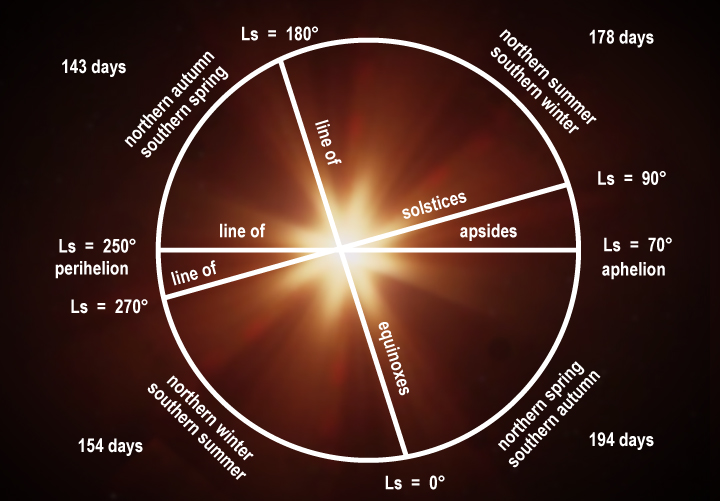
The Martian calendar of Kim Stanley Robinson
The Ls calendar of Kim Stanley Robinson is close to the Darian calendar conceived in 1985 by taking the same number of days for the Martian year, that is to say 668.6 sols. This fractional number should force the author to follow the Darian model which distributes in each Martian decade 6 leap years of 669 days and 4 years of 668 days to reconstitute a total of 6686 sols. In spite of this, all the editions of the novel associate the scheme reproduced above with the following legend: "669 Martian days in total in a Martian year: 24 months of which 21 months of 28 days and 3 months (every eight months) of 27 days" which would imply a decade of 6690 sols, that is to say 4 sols too many!
The Ls calendar spreads the same number of months per year but distributes them in a different way. The Darian calendar places a month of 27 sols every 6 months and the last month of the year has a 28th sol only in Martian leap years.
The Ls calendar deviates in several other ways:
- the novel does not name the months of the year,
- the Ls calendar cuts four seasons in 360 degrees as shown in the excerpt below,
- finally, Kim Stanley Robinson starts his calendar (Year 1) in 2027, the year of the arrival of his colonists on Mars. The Darian calendar was controversial because it started its chronology at the end of 1975 when the first Viking space probe landed on Mars. This choice was quickly considered extremely restricted and had the consequence of giving negative dates to the multiple telescopic observations of the past centuries. The era that is currently preferred is 1609, the date when, based on Tycho Brahe's observations of Mars, Johannes Kepler elucidated the laws of planetary motion. 1609 is also the year of the first observation of Mars with a telescope by Galileo.
"Do you realize it's Ls seventy already? Phyllis said one night. "Didn't we land at Ls seven?"
So they had been on Mars for half a martian year. Phyllis was using the calendar devised by planetary scientists; among the colonists it was becoming more common than the terran system. Mars's year was 668.6 local days long, and to tell where they were in this long year it took the Ls calendar. This system declared the line between the sun and Mars at its northern spring equinox to be O°, and then the year was divided into 360 degrees, so that Ls = 0°-90° was the northern spring, 90°-180° the northern summer, 180°-270° the fall, and 270°-360° (or 0° again) the winter.
This simple situation was complicated by the eccentricity of the martian orbit, which is extreme by terran standards, for at perhelion Mars is about fortythree million kilometers closer to the sun than it is at aphelion, and thus receiving about 45% more sunlight. This fluctuation makes the southern and northern seasons quite unequal. Perihelion arrives every year at Ls = 250°, late in the southern spring; so southern springs and summers are much hotter than northern springs and summers, with peak temperatures as much as thirty degrees higher. Southern autumns and winters are colder, however, occurring as they do near aphelion—so much colder that the southern polar cap is mostly carbon dioxide, while the northern one is mostly water ice.
So the south was the hemisphere of extremes, the north that of moderation.
And the orbital eccentricity caused one other feature of note; planets move faster the closer they are to the sun, so the seasons near perihelion are shorter than those near aphelion; the northern autumn is 143 days long, for instance, while northern spring is 194. Spring fifty-one days longer than autumn! Some claimed this alone made it worth settling in the north.
In any case, in the north they were; and spring had arrived."
Excerpt from: Mars the Red, Kim Stanley Robinsom, pages 84 and 85 of the English edition, ©1993, Spectra Publishing.
Documentary sources, articles, databases:
Wikipedia |
USGS |
IAU |
Nasa |
MSSS
All the documents presented here are linked to their owners on their respective official site. ©Ifik |
Contact